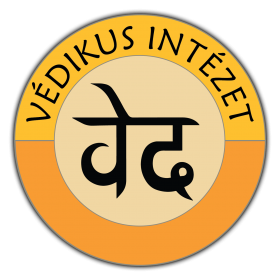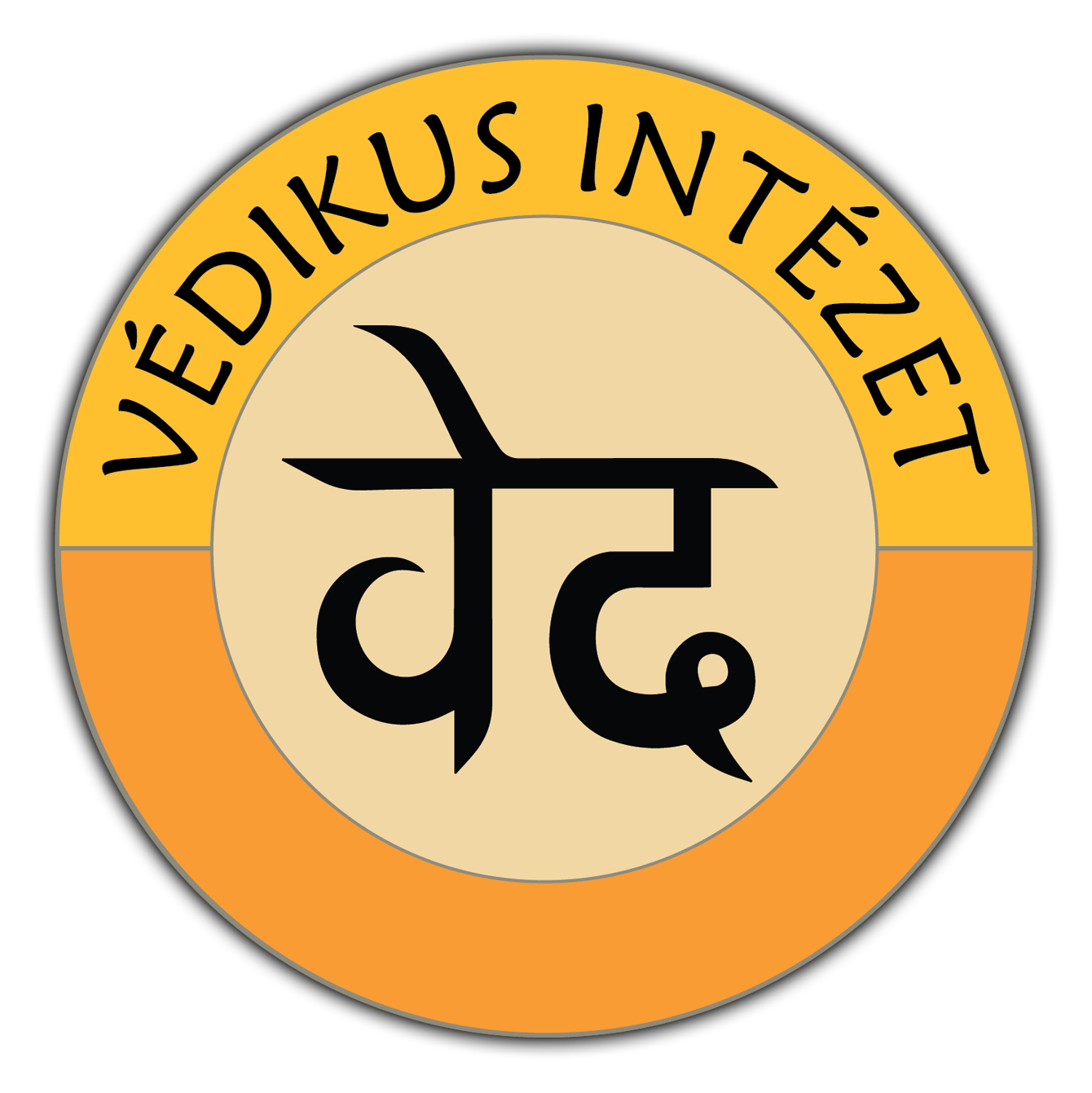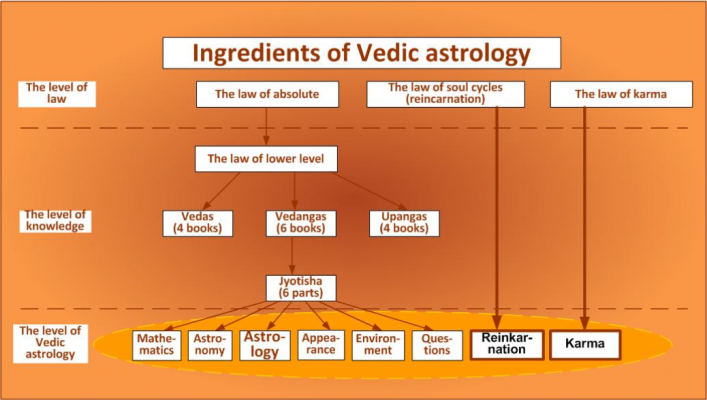ABOUT VEDIC ASTROLOGY
Continuing from the main page:
Main literature source of Vedic astrology (picture was constructed using BHF notes):
On the level of law:
- The law of absolute knowledge
- The law of soul cycles (reincarnation)
- The law of karma
On the level of knowledge: the 6 books of Vedangas
The level of Vedic astrology:
This is what Dr. Tóth-Soma László / Gaura Krisna Dásza writes about the levels of Vedic astrology in his book, ’Bevezetés a védikus irodalomba’ (Introduction to Vedic literature) (Bhaktivedanta Hittudományi Főiskola, 2009):
“The word jyoti means ‘radiant’ (according to other sources its meaning is ‘path towards light’, i.e. God), actually denoting planetary bodies. In fact, it synthesizes the science of time and it defines the length of various time units, such as that of months, days, parts of the days, etc. From a practical point of view, it regulates when to perform religious rituals or any kind of ordinary action during the days of the week. Jyotisha consists of 6 parts:
- Mathematics (ganita),
- Astronomy in its narrower definition (jyotisha),
- Astrology (jatika),
- Physiognomy (samudrika, the outer appearance),
- Omens (nimitta, environment), and
- The science of asking and responding (prashna), query.
The first two of this list (ganita, jyotisha) are descriptive sciences, while the last four (jatika, samudrika, nimitta, prashna) are explanatory. This difference arises because one can find exclusively exact statements in descriptive sciences that are independent of one’s understanding, while conclusions derived from explanatory sciences are not independent of one’s understanding. Thus, in the case of the last four sciences, interpretation is always necessary.
- Ganita – the various branches of mathematics (algebra, geometry, trigonometry, etc.) are primarily used to define the precise location of the planets.
- Jyotisha – or astronomy describes the position of planets at a given time point. The following four sciences are applied by relying on the former two, by using their data, and by attaching explanations to them:
- Jatika – or astrology describes how the position of planets at the birth of a person influences his fate.
- Samudrika – or physiognomy describes the effect of planetary positions at birth on the shape of the human body. A scientist, who is familiar with physiognomy, can estimate the personality and fate of a man from the shape of his body and other characteristics.
- Nimitta – the science of omens demonstrates the effect of planetary positions on the environment. According to scriptures, planets will create different situations depending on our actions, and at the same time they will manifest specific changes in our environment by which it is possible to deduce certain future life events. These specific sign are the so called ‘omens’.
- Prashna – the science of queries deals with the effect of planetary positions on verbal questions. This means that if someone in India or around the world visits a credible and erudite astrologer, then at the moment his question is born, the astrologer will ascertain the planetary positions and will read the answers accordingly.
The most well-known Jyotisha-Sastras are those processing the theme of Astronomy. Examples include Sjrya-siddhanta and Siddhanta-shiromani. Astrology is described in its fullness in Hora-Sastra, but Bhrigu-samhita is also granted high prestige.
Let us now examine the 6 differences between Vedic and Mesopotamian (Western) astrology.
1. Differences due to planetary positions (23.5 °):
Western astrology is based on the orientation of Earth compared to the Sun and it uses the tropical zodiac. Tropical zodiac is an imaginary belt divided into 12 zodiac signs that deviates about 8 ° both to the north and to the south from the ecliptic (the Sun’s apparent path on the celestial sphere during one year, or the Earth’s orbiting plane in the solar system). It supposes that every year, during the spring equinox the Sun is in Aries 0 ° and during the autumn equinox it is in Libra 0 ° (Cancer 0 ° during the summer solstice and Capricorn 0 ° during the winter solstice). Thus, the precession of equinoxes is not taken into account, which is, however, taken into consideration by Vedic astrology. In other words, looking up from Earth in reference to the fixed stars, the Sun does not return to the same place on the 21st March where it was a year earlier. Thus, the deviation in the basis of calculation between Western and Eastern (Vedic) astrology is 50 seconds of 1 ° during a year, mounting to 1 ° in 72 years, 30° in 2160 years (the backlog a whole zodiac sign!!!). A whole cycle is completed in 25920 years. The last time when the position of the planets according to the two calculations was the same occurred during 285 BC. Currently, the difference between the calculations of the two zodiacs is about 24 ° (Ayanamsha). This roughly means that 4 out of 5 people were not born in the zodiacal sign they were identified with according to Western astrology.
An example showing the differences of signs:
|
Astrology |
Beginning of Aries |
End of Aries |
|
Mesopotamian |
21st March |
20th April |
|
Vedic |
13th April |
14th May |
This approximately 23.5 ° difference is true for each other planet as well (22 calendar days).
2. What types of heavenly bodies are used?
Western and Vedic astrology both use the 12 zodiac signs, the Sun, inner planets (Moon, Mars, Mercury, Jupiter, Venus, Saturn), and outer planets (Uranus, Neptune, Pluto). Vedic astrology also uses the two nodes of the moon (they even move along the ecliptic due to the Moon rotating around the Earth). These are the North and South Nodes (Rahu and Ketu, respectively). The two nodes form the karma axis, which plays a pivotal role in the philosophy of Vedic astrology.
3. Principles unchanged for millennia
By discovering new planets or constellations, the principles of Western astrology are continuously changing, while those of Vedic astrology have remained unchanged for thousands of years.
4. Conceptual differences
Western (in other words tropical) astrology is Sun-based, mostly centered on the personality and character, so man’s nature is likened to the Sun.
Vedic (in other words cosmic or sidereal) astrology studies the interplay of fixed stars and the solar system’s planets on human life. Thus, it covers all fields of life. It pinpoints our desires, inherent talents, our abilities to assume responsibility and our capabilities for spiritual development. It is capable of forecasting the timing and interval of life’s most important events.
5. 27 fixed stars (Moon sub-houses) in Vedic astrology
Western astrology uses primarily the 12 zodiac signs, taking into account planetary and stellar influences, as well.
Vedic astrology further divides the 12 houses into additional 27 sub-houses (Nakshatras) (27 * 13° 20’ = 360°). This enables a much more precise forecast in time. There is no such possibility in Western astrology.
6. Forecasting systems
Western astrology uses progressions and planetary transits to time events and changes. Vedic astrology also uses these, especially planetary periods (Dashas). In Vimshottari Dasha all 9 planets (the Sun, inner planets, Rahu and Ketu) represent a time zone between 6-20 years (120 years in total). They will determine which of these exerts its effect to a person’s life at a given moment. When one’s precise birth time is known (year, month, day, hour, minute), Dasha will predict the beginning and ending of his exceptional time periods.
Main principles of Jyotish:
- Experiencing and achieving the higher level wisdom or the absolute: it’s beyond the mind. It cannot be known by ordinary reasoning. This is the underlying goal of human existence. It is every human’s basic nature, it is itself infinite knowledge, awareness and bliss. The goal is to return to the Absolute and freeing one from the cycles (birth-death).
- Lower level knowledge: it consists of the 4 Vedas (Rig, Yajus, Sama and Atharva) and 6 Vedangas (grammar, etymology, intonation, prosody, rituals and astrology). According to the Uppanishads, these help one recognize creation’s transcendental nature.
- Reincarnation (rebirth): only the body dies, the soul will go on and continues to live in a new form (body). The natal chart summarizes the results of past incarnations, the main motifs of the present one, and it implies at the future lives, too.
- The law of karma (action): the events of our current life are the result of our past actions, and the way we react on these will determine our future. According to the eternal law of karma, every soul has the opportunity to find the way out via their selfless thoughts and good deeds, and thus, to step out of this world. (“’You reap what you sow.”)
Paramahansa Yogananda: “Astrological stars of a person are nothing but an environment that he himself has chosen by the karmic pattern he has fashioned by his past life actions. According to this karmic pattern, he is attracted to be reborn on earth at a given time that is favourable to the fulfillment of that pattern.”
I hope, dear Reader, that your time reading this was not spent in vain. If it further aroused your interest towards Vedic astrology, then by clicking to “Contact”, you’ll find my contact details.
… and we’ll meet at chart analysis, and/or at a Vedic astrology course, and/or at astro- meditation…!
I’m looking forward to your e-mail and/or phone call.
Judit Saródy,
Vedic astrologer, certified Vedic (vaishnava) theologist and astrotherapist (integral therapist)


 Magyar
Magyar
